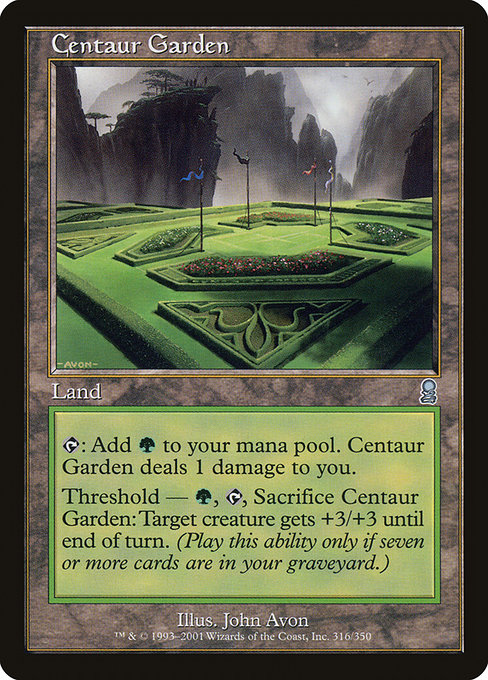
Image courtesy of Scryfall.com
Alt Art Proxies for a Classic Green Favorite
If you’ve wandered into the world of custom proxies and art variants, you’ve stumbled upon a vibrant subculture that celebrates the MTG hobby beyond the battlefield. Centaur Garden, a green-tinged landmark from Odyssey’s early-2000s era, is a favorite target for alt-art proxies and collector-focused variants. The card’s spare, nature-forward flavor combined with a potent threshold moment gives proxy artists a broad canvas: lush forests, towering centaurs, or surreal landscapes where magic grows from the soil itself. 🧙🔥💎
Why Centaur Garden stands out in the proxy space
Centaur Garden is a land with a quiet, stubborn personality. It taps for green mana, but it also deals 1 damage to you—no free lunch here. The true trick, though, is the Threshold ability: when seven or more cards are in your graveyard, you can sacrifice this land to give a targeted creature +3/+3 until end of turn. That tactical nudge can swing combat in mid to late game turns, especially in grindy green strategies that lean on the graveyard as a second deck engine. It’s a flavorful card that rewards meticulous play and careful counting, a perfect muse for artists and players crafting alt-art visions. ⚔️🎨
Card snapshot: what you should know at a glance
- Name: Centaur Garden
- Type: Land
- Set: Odyssey (ODY) — released 2001-10-01
- Rarity: Uncommon
- Mana Cost / CMC: 0 / 0
- Color Identity: Green (G)
- Oracle Text: {T}: Add {G}. This land deals 1 damage to you. Threshold — {G}, {T}, Sacrifice this land: Target creature gets +3/+3 until end of turn. Activate only if seven or more cards are in your graveyard.
- Keywords: Threshold
- Art: John Avon
- Finish: Foil and nonfoil; image status highres
Alt art proxies: a blend of craft and nostalgia
Alt-art proxies exist at the intersection of art, memory, and utility. For Centaur Garden, proxy artists often lean into imagery that emphasizes growth, guardianship, and the wild edges where magic and nature meet. Whether the alt art emphasizes a serene forest glade or a dramatic, action-packed battlefield between centaurs and creeping flora, these variants invite collectors to reimagine a familiar card through a personal lens. In the modern MTG community, proxies are a popular way to enjoy display pieces, test deck aesthetics, and celebrate the imagery that drew us to the game in the first place. 🧙🔥🎲
“Proxy art isn’t just about copying; it’s about reinterpreting a moment on the battlefield. Centaur Garden’s threshold twist becomes a narrative cue in every alt-variant, a reminder that green’s power often hides in patient growth.”
Flavor and design: John Avon’s enduring vision
John Avon’s work on Odyssey-era cards is iconic. His landscapes tend to breathe—lush, sun-dappled, and just a touch mystical. Centaur Garden captures a moment where verdant life presses up against the edges of a battlefield’s calculus. In alt-art form, that tension can become a frozen reaction shot: a glade where the forest itself leans closer, or a pastoral scene with a hidden, thrumming enchantment. For proxy builders and collectors, Avon’s art provides a rich starting point for variants that feel both nostalgic and contemporary. The art, paired with the land’s dual role as a mana source and a potential combat finisher, makes it a prime candidate for visually striking edits that remain faithful to the card’s core identity. 🎨💎
Collectibility, value, and the proxy conversation
Odyssey is a cornerstone set for many players who appreciate the early days of in-depth green strategy and the Threshold mechanic that defined a generation of decks. In the proxy market, Centaur Garden variants often serve as showcase pieces—gently aged scans, tasteful borders, and faithful type lines that keep the card recognizable while offering something new to admire. Official price data from Scryfall’s print run paints a snapshot: around USD 0.71 for non-foil copies and higher values for foil options, with foils sometimes fetching multi-figure prices for well-preserved or reimagined art. While proxies rarely impact tournament legality, they shine in casual play and display cases, turning a familiar card into a living gallery piece. The collector’s joy here is less about power and more about storytelling—the moment in the graveyard where seven cards become a gateway to a surprise +3/+3 shove, framed by a forest canopy that seems almost alive. 🧙🔥⚔️
Practical guidelines for crafting alt art proxies
- Respect the core identity: Keep the mana symbol, color identity, and key text readable so players recognize the card’s function at a glance.
- Preserve balance cues: Ensure that the proxy reflects the card’s strength and limitations in gameplay context, especially the threshold trigger.
- Document provenance: Note the artwork reference and set origin so future owners understand the alt-variant’s lineage.
- Quality matters: High-resolution scans and careful color correction help maintain fidelity while celebrating the alt-art spirit.
Where to look and what to expect
Collectors exploring Centaur Garden proxies often shop in specialized MTG communities, card shows, and reputable proxy studios. The appetite for green-themed alt art aligns with the card’s atmospheric storytelling and the tangible nostalgia of Odyssey’s era. If you’re balancing practicality with passion, a thoughtfully crafted proxy can be a centerpiece in a casual Commander night or a conversation starter on a game day. And for fans who enjoy aligning their hobby with tactile desk gear, a well-chosen desk mat or mouse pad can complement your display cards nicely—the kind of cross-pollination that makes hobby spaces sing. 🧙🔥🎲